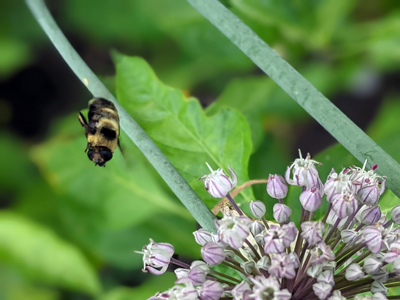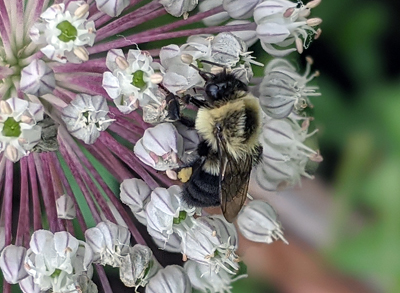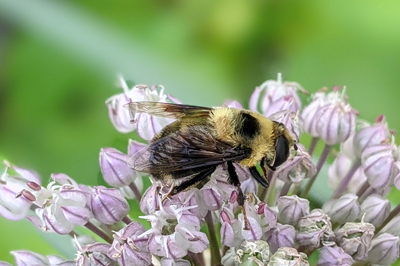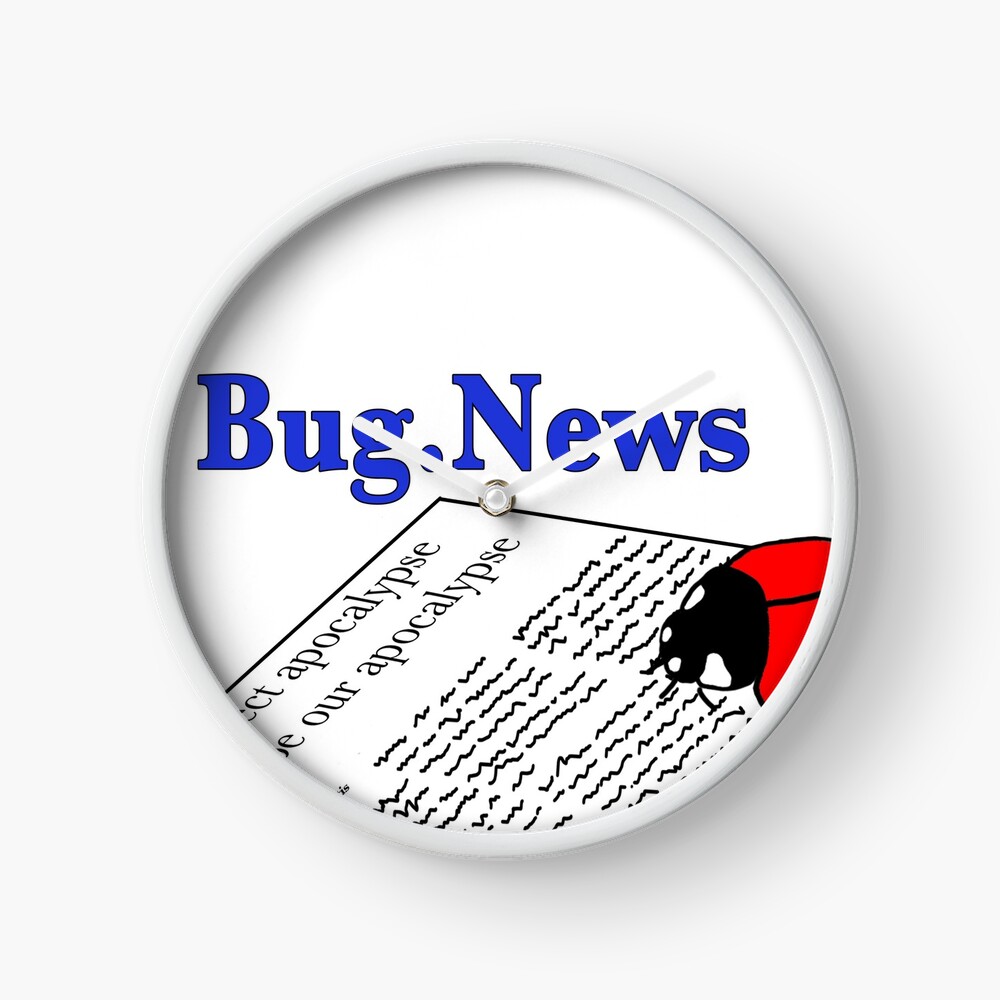
One of these things is not like the other… One of these things is just pretending… Can you tell which one is the bee and which one is the bee mimic?
This is one of the very best bee mimics I’ve seen. I was super excited (and really lucky!) to actually manage to get a decent picture of BOTH the mimic and the bee in the same frame. Hooray 😄!
The fuzzy looking critter on the right is the real bee, the Common Eastern Bumble Bee, Bombus impatiens, while the fuzzy looking critter on the left is an impostor! This impostor is actually a type of fly! This is the Hairy-eyed Mimic, Mallota posticata, in the taxonomic family Syrphidae (Hover Flies).

This type of mimicry, where a benign organism pretends to be a harmful organism, is called Batesian mimicry. By mimicking the bumble bee, the fly gains protection and is less likely to be eaten. Because what predator wants to risk getting stung by a bumble bee instead of just eating something else that doesn’t sting? If I were a bird, I’d sure go for the non-stinging bugs. To really make the ruse believable, not only does this fly mimic the way the bumble bee looks, it also mimics the way it acts and hangs out in the same places! Talk about dedication to the act.
Believe it or not, as I’m hovering (lol see what I did there?) around the flowers trying to get decent images of the bee mimic, it actually took a few runs at me! I’d get my phone too close and it would get irritated, make angry buzzing noises, and dart at me pretending it would sting me. Silly fly, I’m an entomologist. I know you can’t hurt me! The real bee on the other hand, couldn’t care less about me sticking my phone all up in its face. Granted it didn’t try to hold still for its photoshoot, but it never buzzed at or made angry motions my way. Pretty ironic, don’t you think?

I think the only way in which M. posticata doesn’t mimic bumble bees is their larvae (aka baby flies or maggots). Unlike, bumble bees that nest in the ground in small colonies, baby M. posticata actually live in leaf litter or tree hollows where they can feed on decomposing matter until they turn into adults. Please note, do not try to harvest “honey” from bumble bee nests. Unlike the Honey Bee, Apis mellifera, bumble bees do NOT make extra honey. If you take their honey (which doesn’t taste the same anyway), the baby bees will die.
While bees get most of the credit for pollination services (and rightly so!), a number of flies are also important pollinators. Like this bee mimic. See how fuzzy it is? Well, all those hairs are great at picking up pollen. That’s one of the big reasons bees are so good at pollinating flowers. Fun fact: the hairs bees have are actually branched, or feathered, to better pick up pollen. If you ever have a chance to look at one under a microscope, check it out! And clearly this bee-mimicking fly is feeding on the flowers so… Flower visiting + hairiness = a good pollinator :)

FYI – If you’ve never let your leek or onion plants flower, you might want to consider it. The bees and other pollinators in my garden seem to LOVE them. I’ve let my chives, regular onions, green onions, and leeks flower. There hasn’t been a single day (except in the rain) when I haven’t seen pollinators on the Allium (genus for oniony things) flowers. Usually native bees, but I’ve also seen some beneficial wasps, flies, and other things (more stories to come).

For more information check out:
- Nature Search
- Scientific paper: Relationship of water and leaf litter variability to insects inhabiting treeholes
- Scientific paper: The Relationship between Morphological and Behavioral Mimicry in Hover Flies (Diptera: Syrphidae)
Support the blog
Like my blog? Want to help keep the new content coming and the pages ad free? Consider becoming one of my Patreon Patrons! Any amount, big or small, helps me spend more time creating and less time trying to keep the lights on. Patreon Patrons can also get exclusive access to monthly newsletters, story sneak peeks, story requests, and more! Please consider supporting the blog and check out my Patreon Patron support page.
Ok, you say, but what is this Patreon thing you are talking about? Patreon is a service that helps connect content creators with folks who want to help support creative endeavors. Patreon is setup to be able to safely handle the financial side of transactions so both the patron and the creator can be confident their information is secure. You can read more about what Patreon is HERE.
Thank you!!
Not interested in a Patreon monthly subscription? Prefer to make a one-time contribution? We have that option too! Help support the blog with a one-time donation through PayPal instead! Thank you!!
Gifts & Swag Galore
Now you can get prints of some of our favorite critters on Red Bubble! Everything from tote bags and pillows, to greeting cards and note books, to t-shirts and mugs!
Check out it out HERE. The store is organized by design, so pick a critter picture to see all the gift options :)
Here are just a few examples:
And so much more! Check out all the bug patterns HERE.
Join the email list
Want Bug News stories & announcements sent to your inbox? Never miss a story: Join the Bug News email list here or email me at Erika@bug.news with “Join email list” in the subject line.
Questions? Comments? Corrections?
I’d love to know what you thought and what’s on your mind. Email it to me at erika@bug.news. I’ll do everything I can to answer your questions, address your comments, and keep the stories updated :)
We’re also on Facebook so you can leave a comment or start a discussion there too if you prefer that medium…
















